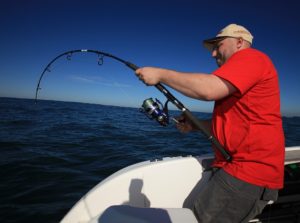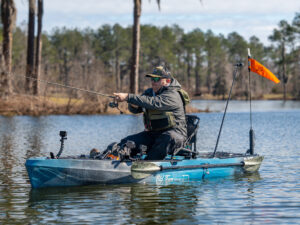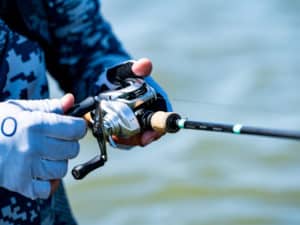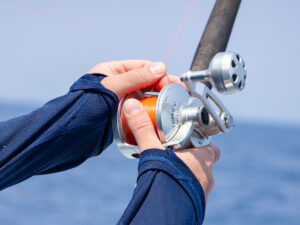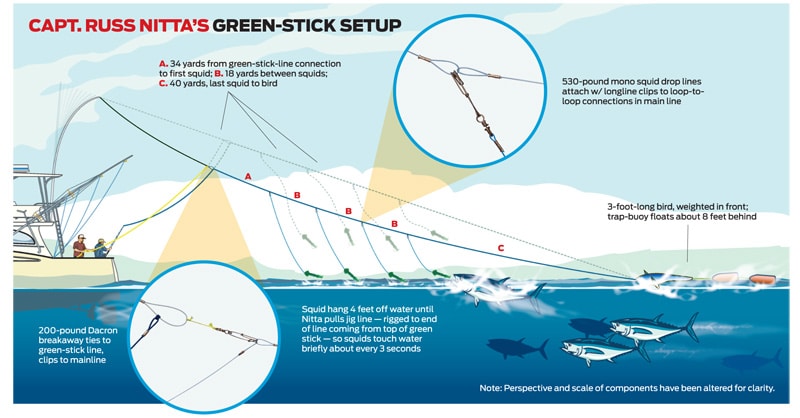
green stick tuna chart
The V of the idling boat’s wake fades into the oily flat sea. Just beyond, two acres of porpoises break the calm as they blow before heading back down to their feast on opelu — Hawaiian mackerel. Between the boat and the porpoise, 150-pound ahi tuna leap from the water, sometimes twisting in midair with acrobatics more common to sailfish than tuna.
Only one thing could provide a much more exhilarating show: yellowfin leaping from the sea to eat trolled artificial squid.
“The yellowfin are competing against porpoises, not just other tuna, so they’re really aggressive,” says Capt. Russ Nitta, owner of Lepika Sportfishing in Kona, Hawaii. “They’re moving 35 mph when they blow up on our squid. It’s spectacular!”
Nitta is green-sticking — the term given to trolling artificial squid from the top of a fiberglass pole more than 30 feet in the air. The plastic squid spend more time out of the water than in, which he says is as effective as it is exciting.
Nitta shares his 10 years of green-stick experience with Sport Fishing readers.
The Stick & Rig
Named for the greenish tint to fiberglass poles made in Japan, green sticks are sold in 11-foot, hollow tapered sections. The outside diameter of the base of one nestles within the inside diameter of the top of the section below it, overlapping 12 inches at the joint. Nitta secures joints with strips of rubber and hose clamps.
Some captains fasten only one section high on the tuna tower. Nitta uses three sections, setting the base section (about the size of a softball) into an aluminum socket on his flying bridge. Another bracket clamps around the pole six feet higher, fastened to his half-tower. This puts the tip 36 feet above the water.
Nitta crimps 700-pound monofilament to a ring at the tip of the green stick. He crimps a loop in the other end, making it just long enough to reach the tip of his trolling rod.Nitta fishes four squid from 100 yards of 400-pound Momoi X-HARD monofilament atop 400-pound spectra braid spooled onto a Fin-Nor 130 reel. He divides his main line into sections with simple crimped loop-to-loop connections.
From each connection, he attaches a longline clip with several yards of 530-pound Momoi X-HARD monofilament. At the other end of each of these drop lines, Nitta rigs 9-inch Mold Craft artificial squid with 11/0 Dozer hooks. “I tie a Flemish knot with the mono where it passes through the hook,” Nitta says. “That keeps the squid from traveling up the drop line, away from the hook.” (See this knot below courtesy of YouTube member chainheart3)
Up in the Air
First in the water goes Nitta’s three-foot-long bird, designed both to attract tuna and tension his whole rig behind the boat.
Forty yards up from the bird, he attaches his first drop line and squid. The next three squid are spaced 18 yards apart. “Tuna think the bird is chasing the squid,” Nitta says. He trolls the closest squid 34 yards from the boat.
These distances vary with each green stick, but Nitta says the length of each squid drop line takes the most tweaking — even changing with a new bird.
With the rig deployed, Nitta attaches the last loop-to-loop connection to the 700-pound monofilament line coming off the tip of his green stick. “I use 200-pound Dacron. That’s what breaks when fish are hooked,” Nitta says. He ties the Dacron to the green-stick line with an improved clinch knot, and attaches the other end of the Dacron to the main fishing line with a longline clip. Letting line off the reel shifts tension to the green stick, raising the rig.
Thin nylon rope attached to the green-stick line at this intersection allows Nitta to retrieve the green-stick line once it breaks away, and also allows him to jig the squid down into the water. “Use anything that’s light and comfortable to hold in your hand,” Nitta says.
Showtime
“I like to troll my bird right at the front of a pod of porpoise,” Nitta says. At 5 knots, he angles ahead of the predictably moving pod using his fish finder to ensure that tuna are present. “Porpoises usually stay within 120 feet of the surface,” he says. “I’m looking for marks from 150 feet down to 400 feet.”
“My drop lines hold my squid about four feet in the air while trolling,” Nitta says. He pulls down on the jig line every few seconds to bring the squid down to the water, allowing them to touch the surface only briefly. “You can put the fish off by dragging those squid in the water. Yellowfin are used to tracking things in the air. They hit as soon as their prey hits the water,” Nitta says. “They don’t miss often.”
Once hooked up, the angler reels while Nitta detaches unhooked drop-line clips as they come in, ready to leader hooked tuna to the gaff. “I like to fight them off the side of the boat from a dead boat,” Nitta says.
“It’s not unusual to have multiples,” Nitta says, recounting a memorable triple. “One fish took the squid closest to the boat. It jumped 10 feet in the air. Another took the squid closest to the bird. As those two landed in the water, a third fish blew up in the middle.”
With three ahi hooked, the mainline broke — normally drawing the curtain on any fishing show — but Nitta rigs a couple of two-foot-long bullet-shaped fishing floats about eight feet behind his bird, providing an encore by retrieving the other end of the line.
What tops such aerial acrobatics? Fresh sashimi with the show!
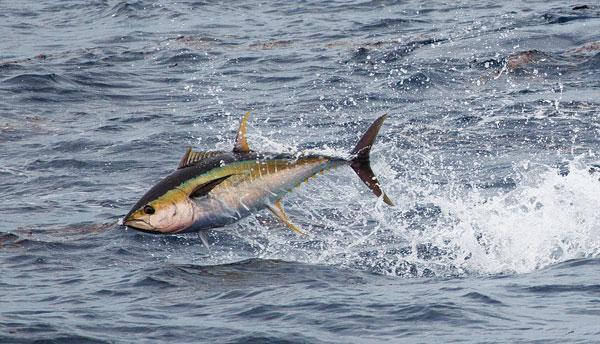
About the expert: Russ Nitta grew up fishing with his father offshore of Oahu. He’s since fished both coasts of North America but prefers Kona’s calm waters and big fish.
_Tuna photo by Capt. Josh Temple
_

